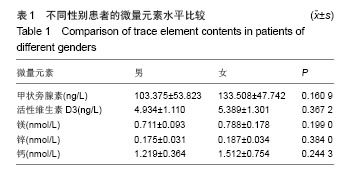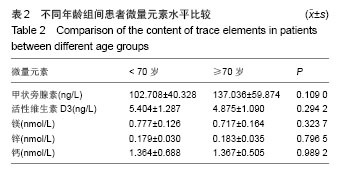| [1]Caton JH, Prudhon JL, Ferreira A, et al. A comparative and retrospective study of three hundred and twenty primary Charnley type hip replacements with a minimum follow up of ten years to assess wether a dual mobility cup has a decreased dislocation risk. Int Orthop. 2014; 38(6): 1125-1129.
[2]Nakashima Y, Sato T, Yamamoto T, et al. Results at a minimum of 10 years of follow-up for AMS and PerFix HA-coated cementless total hip arthroplasty: impact of cross-linked polyethylene on implant longevity. J Orthop Sci. 2013;18(6):962-968.
[3]Landor I, Vavrík P, Jahoda D, et al. Long-term experience with the combined ARBOND hydroxyapatite coating in implant osteointegration. Acta Chir Orthop Traumatol Cech. 2009; 76(3): 172-178.
[4]Bidwell JP, Alvarez MB, Hood M Jr, et al. Functional impairment of bone formation in the pathogenesis of osteoporosis: the bone marrow regenerative competence. Curr Osteoporos Rep. 2013;11(2):117-125.
[5]Stroncek DF, Sabatino M, Ren J, et al. Establishing a bone marrow stromal cell transplant program at the National Institutes of Health Clinical Center. Tissue Eng Part B Rev. 2014;20(3) :200-205.
[6]沈奕,李晓淼,傅晓东,等.股骨近端Stro-1+细胞与骨形态发生蛋白及其受体的相关性[J].中国组织工程研究, 2012,16(45): 8380-8384.
[7]Zofková I, Nemcikova P, Matucha P. Trace elements and bone health. Clin Chem Lab Med. 2013;51(8):1555-1561
[8]Vignon E, Valat JP, Rossignol M, et al. Osteoarthritis of the knee and hip and activity: a systematic international review and synthesis (OASIS).Joint Bone Spine. 2006;73(4): 442-455.
[9]Caviglia HA, Osorio PQ, Comando D. Classification and diagnosis of intracapsular fractures of the proximal femur. Clin Orthop Relat Res. 2002;(399):17-27.
[10]柳向东,柴冈,李东,等,成人骨髓间充质干细胞的体外培养和表型鉴定[J].上海第二医科大学学报,2004,4(24):300-301.
[11]Semenowicz J, Mroczka A, Kajzer A, et al. Total hip arthroplasty using cementless avantage cup in patients with risk of hip prosthesis instability. Ortop Traumatol Rehabil. 2014;16(3):253-263.
[12]Gallo J, Vaculova J, Goodman SB, et al. Contributions of human tissue analysis to understanding the mechanisms of loosening and osteolysis in total hipreplacement. Acta Biomater. 2014;10(6):2354-2366.
[13]Cappariello A, Maurizi A, Veeriah V, et al. The Great Beauty of the osteoclast. Arch Biochem Biophys. 2014;558:70-78.
[14]Zaidi M, Moonga BS, Huang CL.Calcium sensing and cell signaling processes in the local regulation of osteoclastic bone resorption. Biol Rev Camb Philos Soc. 2004;79(1): 79-100.
[15]Rocque BG, Kelly MP, Miller JH, et al. Bone morphogenetic protein-associated complications in pediatric spinal fusion in the early postoperative period: an analysis of 4658 patients and review of the literature.J Neurosurg Pediatr. 2014;14(6): 635-643.
[16]Carreira AC, Alves GG, Zambuzzi WF, et al. Bone Morphogenetic Proteins: structure, biological function and therapeutic applications. Arch Biochem Biophys. 2014;561: 64-73.
[17]Marini JC, Reich A, Smith SM. Osteogenesis imperfecta due to mutations in non-collagenous genes: lessons in the biology of bone formation. Curr Opin Pediatr. 2014;26(4):500-507.
[18]赵益峰,王海滨,孟纯阳,等.节段性骨缺损修复过程中几种微量元素含量的研究[J].实用骨科杂志, 2010,16(2):113-117.
[19]Anné J, Edwards NP, Wogelius RA, et al. Synchrotron imaging reveals bone healing and remodelling strategies in extinct and extant vertebrates. J R Soc Interface. 2014;11(96): 20140277.
[20]Engh CA, Mcauley JP, Sychterz CJ, et al. The accuracy and reproducibility of radiographic assessment of stresss-shielding. J Bone Joint Surg (Am). 2000; 82(10): 1414-1420.
[21]Weinans H, Sumner DR, Igloria R, et al. Sensitivity of periprosthetic stress- shielding to load and the bone density-modulus relationship in subject-specific finite element models. J Biomech.2000; 33(7):809-817.
[22]Cohen B, Rushton N. Accuracy of DEXA measurement of bone mineral density after total hip arthroplasty. J Bone Joint Surg Br.1995;77(3):479-483.
[23]Hasegawa T, Hongo H, Sasaki M, et al. Biological function of bone cells on the PTH-driven anabolic effect. Clin Calcium. 2012;22(3):373-379.
[24]Aslan D, Andersen MD, Gede LB, et al. Mechanisms for the bone anabolic effect of parathyroid hormone treatment in humans. Scand J Clin Lab Invest. 2012;72(1):14-22.
[25]Kurabayashi M. Bone and calcium update; diagnosis and therapy of bone metabolism disease update. Calcification of atherosclerotic plaques: mechanism and clinical significance. Clin Calcium. 2011;21(12):43-50.
[26]Goltzman D, Hendy GN, White JH. Vitamin D and its receptor during late development. Biochim Biophys Acta. 2015;1849(2):171-180.
[27]Calvo MS, Tucker KL.Is phosphorus intake that exceeds dietary requirements a risk factor in bone health? Ann N Y Acad Sci. 2013;1301:29-35.
[28]Takeda E, Yamamoto H, Yamanaka-Okumura H, et al. Increasing dietary phosphorus intake from food additives: potential for negative impact on bone health. Adv Nutr. 2014; 5(1):92-97.
[29]Calvo MS, Moshfegh AJ, Tucker KL. Assessing the health impact of phosphorus in the food supply: issues and considerations. Adv Nutr. 2014;5(1):104-113.
[30]Cândido FG, Bressan J. Vitamin D: link between osteoporosis, obesity, and diabetes? Int J Mol Sci. 2014;15(4):6569-6591.
[31]Cranney A, Horsley T, O'Donnell S, et al. Effectiveness and safety of vitamin D in relation to bone health. Evid Rep Technol Assess (Full Rep). 2007;(158): 235.
[32]Chung M, Balk EM, Brendel M, et al. Vitamin D and calcium: a systematic review of health outcomes. Evid Rep Technol Assess (Full Rep). 2009;(183):420.
[33]Lani A, Kourkoumelis N, Baliouskas G, et al. The effect of calcium and vitamin D supplementation on osteoporotic rabbit bones studied by vibrational spectroscopy. J Biol Phys. 2014.
[34]Kemi VE, Kärkkäinen MU, Karp HJ, et al. Increased calcium intake does not completely counteract the effects of increased phosphorus intake on bone: an acute dose-response study in healthy females. Br J Nutr. 2008;99(4):832-839.
[35]Gilaberte Y, Aguilera J, Carrascosa JM, et al. Vitamin D: evidence and controversies. Actas Dermosifiliogr. 2011; 102(8): 572-588.
[36]Souberbielle JC, Maruani G, Courbebaisse M. Metabolism and main effects of vitamin D. Presse Med. 2013;42(10): 1343-1350.
[37]Leccia MT. Skin, sun exposure and vitamin D: facts and controversies. Ann Dermatol Venereol. 2013;140(3):176-182.
[38]Frost HM. From Wolff's law to the Utah paradigm: insights about bone physiology and its clinical applications. Anat Rec. 2001;262(4):398-419.
[39]Aldinger PR, Sabo D, Pritsch M, et al. Pattern of periprosthetic bone remodeling around stable uncemented tapered hip stems: a prospective 84-month follow-up study and a median 156-month cross-sectional study with DXA. Calcif Tissue Int. 2003;73(2):115-121.
[40]Venesmaa PK, Kröger HP, Miettinen HJ, et al. Monitoring of periprosthetic BMD after uncemented total hip arthroplasty with dual-energy X-ray absorptiometry--a 3-year follow-up study. J Bone Miner Res. 2001;16(6):1056-1061. |



.jpg)